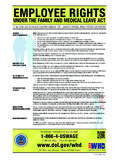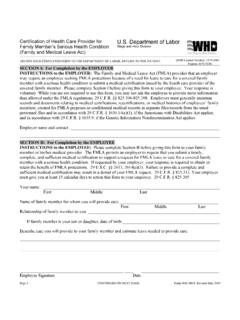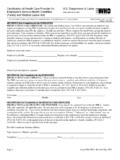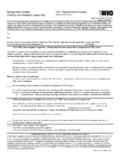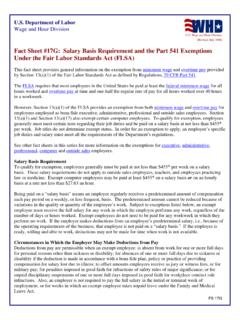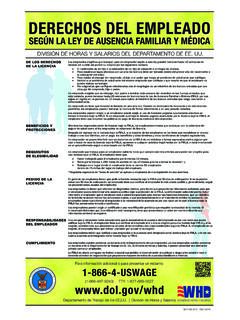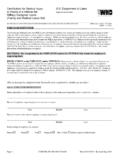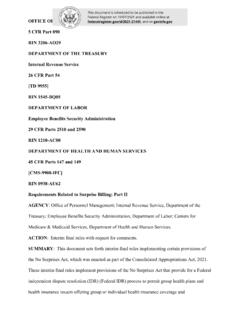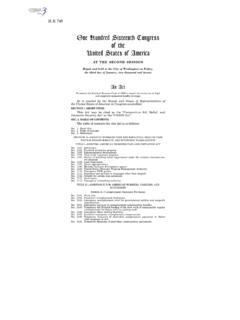Transcription of FAQS ABOUT MENTAL HEALTH AND SUBSTANCE USE …
1 FAQS ABOUT MENTAL HEALTH AND SUBSTANCE USE DISORDER PARITY IMPLEMENTATION AND THE CONSOLIDATED appropriations ACT, 2021 PART 45 April 2, 2021 The Consolidated appropriations Act, 2021 (the appropriations Act) amended the MENTAL HEALTH Parity and Addiction Equity Act of 2008 (MHPAEA) to provide important new protections. The Departments of Labor (DOL), HEALTH and Human Services (HHS), and the Treasury (collectively, the Departments ) have jointly prepared this document to help stakeholders understand these amendments. Previously issued Frequently Asked Questions (FAQs) related to MHPAEA are available at #Mental_Health_Parity. MENTAL HEALTH Parity and Addiction Equity Act of 2008 MHPAEA generally provides that financial requirements (such as coinsurance and copays) and treatment limitations (such as visit limits) imposed on MENTAL HEALTH or SUBSTANCE use disorder (MH/SUD) benefits cannot be more restrictive than the predominant financial requirements and treatment limitations that apply to substantially all medical/surgical benefits in a In addition, MHPAEA prohibits separate treatment limitations that apply only to MH/SUD benefits.
2 MHPAEA also imposes several important disclosure requirements on group HEALTH plans and HEALTH insurance issuers. The MHPAEA final regulations require that a group HEALTH plan or HEALTH insurance issuer may not impose a non-quantitative treatment limitation (NQTL) with respect to MH/SUD benefits in any classification unless, under the terms of the plan (or HEALTH insurance coverage) as written and in operation, any processes, strategies, evidentiary standards, or other factors used in applying the NQTL to MH/SUD benefits in the classification are comparable to, and are applied no more stringently than, the processes, strategies, evidentiary standards, or other factors used in applying the limitation to medical/surgical benefits in the same Under this analysis, the focus is not on whether the final result is the same for MH/SUD benefits as for medical/surgical benefits, but rather on whether the underlying processes, strategies, evidentiary standards, and other factors are in parity.
3 These processes, strategies, evidentiary standards, and other factors must be comparable and applied no more stringently for MH/SUD benefits than for medical/surgical benefits. Since the enactment of MHPAEA, the Departments have issued guidance and compliance assistance materials to help stakeholders understand the law and its implementing regulations, including the requirements for NQTLs. Most recently, in September 2019, the Departments issued Final FAQs part an effort to promote compliance, the FAQs provided additional examples regarding how the NQTL requirements in the MHPAEA final regulations apply to different fact patterns. The DOL also maintains on its website a MHPAEA Self-Compliance Tool that is intended to help group HEALTH plan sponsors and administrators, HEALTH insurance issuers, State regulators, and other stakeholders determine whether a group HEALTH plan or HEALTH insurance issuer complies with MHPAEA 1 The six classifications of benefits defined in final regulations implementing the requirements of MHPAEA are: (1) inpatient, in-network; (2) inpatient, out-of-network; (3) outpatient, in-network; (4) outpatient, out-of-network; (5) emergency care; and (6) prescription drugs.
4 26 CFR (c)(2)(ii); 29 CFR (c)(2)(ii); and 45 CFR (c)(2)(ii). 2 26 CFR (c)(4)(i); 29 CFR (c)(4)(i); and 45 CFR (c)(4)(i) and 3 FAQs ABOUT MENTAL HEALTH and SUBSTANCE Use Disorder Parity Implementation and the 21st Century Cures Act Part 39 (Sept. 5, 2019), available at 4 2020 MHPAEA Self-Compliance Tool, available at Self -Compliance Tool includes a section on NQTLs that outlines a process for conducting comparative analyses of NQTLs. The MHPAEA Self-Compliance Tool is updated every two years and was most recently updated in 2020 by the DOL (in coordination with the Department of the Treasury and HHS). The Consolidated appropriations Act, 2021 The Consolidated appropriations Act, 2021 was enacted on December 27, 203 of Title II of Division BB of the appropriations Act amended MHPAEA, in part, by expressly requiring group HEALTH plans and HEALTH insurance issuers offering group or individual HEALTH insurance coverage that offer both medical/surgical benefits and MH/SUD benefits and that impose NQTLs on MH/SUD benefits to perform and document their comparative analyses of the design and application of NQTLs.
5 Further, beginning 45 days after the date of enactment of the appropriations Act, these plans and issuers must make their comparative analyses available to the Departments or applicable State authorities, upon request, including the following information: 1. The specific plan or coverage terms or other relevant terms regarding the NQTLs and a description of all MH/SUD and medical or surgical benefits to which each such term applies in each respective benefits classification; 2. The factors used to determine that the NQTLs will apply to MH/SUD benefits and medical or surgical benefits; 3. The evidentiary standards used for the factors identified, when applicable, provided that every factor shall be defined, and any other source or evidence relied upon to design and apply the NQTLs to MH/SUD benefits and medical or surgical benefits; 4.
6 The comparative analyses demonstrating that the processes, strategies, evidentiary standards, and other factors used to apply the NQTLs to MH/SUD benefits, as written and in operation, are comparable to, and are applied no more stringently than, the processes, strategies, evidentiary standards, and other factors used to apply the NQTLs to medical/surgical benefits in the benefits classification; and 5. The specific findings and conclusions reached by the plan or issuer, including any results of the analyses that indicate that the plan or coverage is or is not in compliance with the MHPAEA appropriations Act also provides that the Departments shall request that a group HEALTH plan or issuer submit the comparative analyses for plans that involve potential MHPAEA violations or complaints regarding noncompliance with MHPAEA that concern NQTLs, and any other instances in which the Departments determine appropriations Act further requires the Departments, after review of the comparative analyses.
7 To share information on findings of compliance and noncompliance with the State where the plan is located or the State where the issuer is licensed to do business. Additionally, not later than one year after enactment of the appropriations Act and annually by October 1 thereafter, the Departments must submit to Congress and make publicly available a report that sets forth: 1. A summary of the comparative analyses requested, including the identity of each plan or issuer that is determined not to be in compliance after a final determination; 5 Pub. L. 116-260 (Dec. 27, 2020). 6 Internal Revenue Code (Code) section 9812(a)(8)(A)(i)-(iv), ERISA Section 712(a)(8)(A)(i)-(iv) and Public HEALTH Service (PHS) Act section 2726(a)(8)(A)(i)-(iv).
8 7 Code section 9812(a)(8)(B)(i), ERISA section 712(a)(8)(B)(i), and PHS Act section 2726(a)(8)(B)(i). 2 2. The Departments conclusions as to whether each plan or issuer submitted sufficient information for the Departments to review the comparative analyses requested; 3. For each plan or issuer that submitted sufficient information for the Departments to review the comparative analyses requested, the Departments conclusion as to whether and why the plan or issuer is in compliance with the disclosure requirements of MHPAEA; 4. The Departments specifications for each plan or issuer that did not submit sufficient information for the Departments to review the comparative analyses for compliance; and 5. The Departments specifications of the actions each plan or issuer that the Departments determined is not in compliance must take to be in compliance with MHPAEA, including the reason the Departments determined the plan or issuer was not in compliance.
9 Q1: When must plans and issuers make available their NQTL comparative analyses, as required by the appropriations Act? Plans and issuers that offer both medical/surgical benefits and MH/SUD benefits and impose NQTLs must make their comparative analyses of the design and application of NQTLs available to the Departments or applicable State authorities upon request, beginning 45 days after the date of enactment of the appropriations Act. Because the appropriations Act was enacted on December 27, 2020, the requirement applies beginning February 10, 2021. Accordingly, plans and issuers should now be prepared to make their comparative analyses available upon request. Q2: What information must plans and issuers make available in response to the Departments requests for documentation of their comparative analyses?
10 Plans and issuers should ensure that comparative analyses are sufficiently specific, detailed, and reasoned to demonstrate whether the processes, strategies, evidentiary standards, or other factors used in developing and applying an NQTL are comparable and applied no more stringently to MH/SUD benefits than to medical/surgical benefits, as described further below. To that end, a general statement of compliance, coupled with a conclusory reference to broadly stated processes, strategies, evidentiary standards, or other factors is insufficient to meet this statutory requirement. As explained above, the DOL s MHPAEA Self-Compliance Tool includes robust guidance related to requirements for NQTLs and outlines a process for analyzing whether a particular NQTL meets those requirements.
